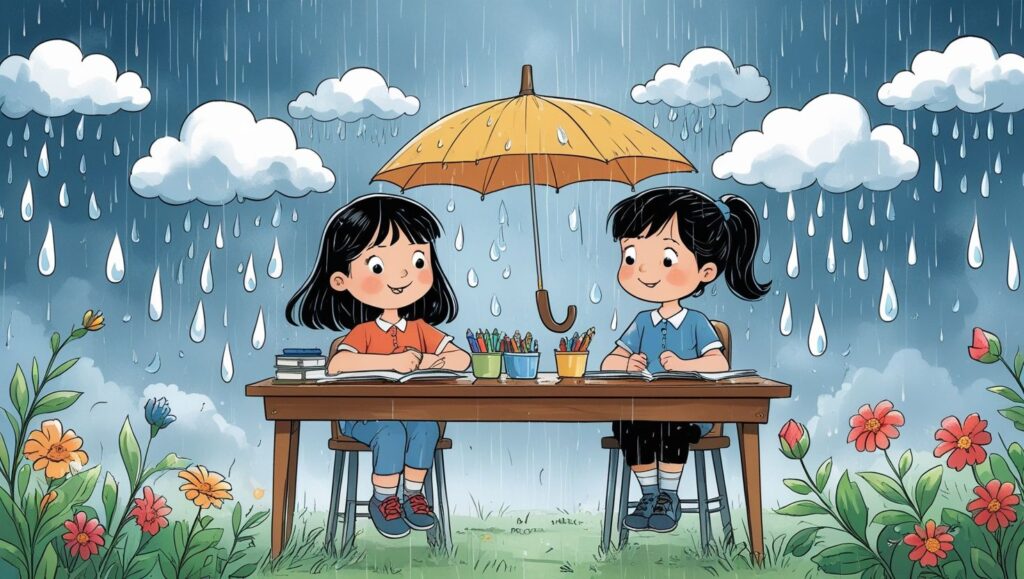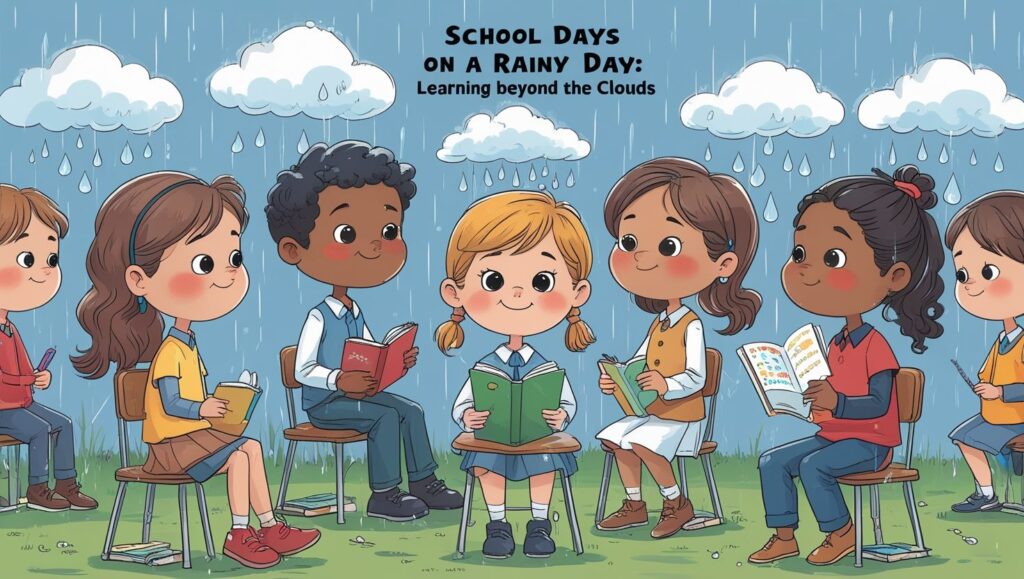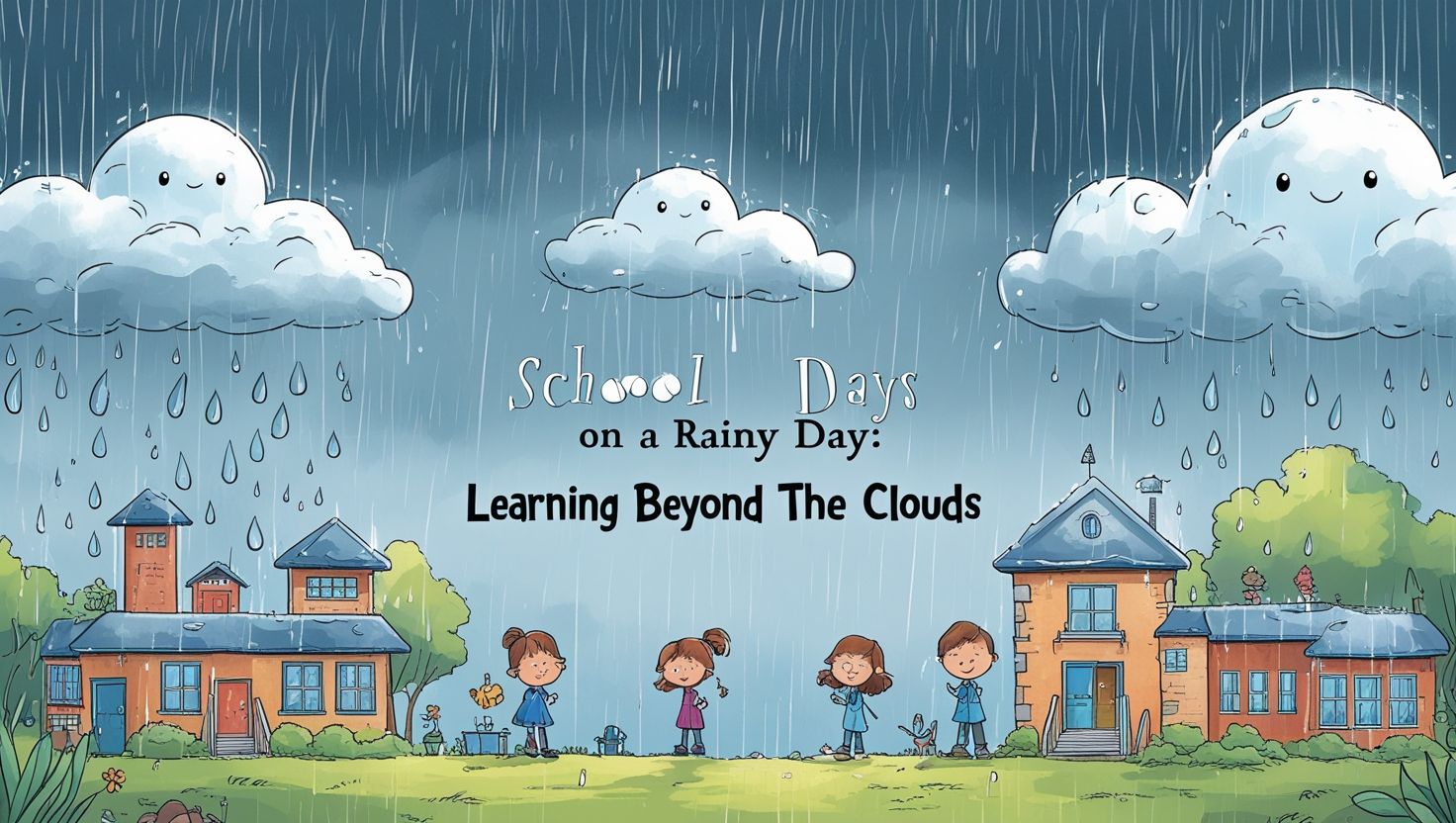1. Introduction:
School Days on a Rainy Day: Learning Beyond the Clouds, Rainy days have a magical way of altering the rhythm of life—and nowhere is this felt more keenly than in schools. The sound of raindrops tapping against window panes, the grey clouds casting a calming hue over the playground, and the rhythmic splashing of puddles bring a unique kind of serenity and excitement. While some might think of rainy days as a barrier to outdoor activities and traditional teaching, they often turn into some of the most memorable school days for students and teachers alike.
These days offer an opportunity to shift gears from routine instruction to something more flexible, creative, and emotionally enriching. The atmosphere itself encourages a slower pace, reflection, and deeper classroom bonding. Students become more attentive, teachers adapt their lessons to suit the mood, and schools often become a haven from the chaos of storms outside.
Far from being disruptions, rainy days can offer new dimensions to learning—bringing in stories, music, art, science discussions about weather, and even philosophical thoughts on nature and life. They allow teachers to focus on soft skills, emotional intelligence, and creative thinking. Most importantly, they give students a memory of comfort and curiosity associated with school life.
In this article, we will explore how rainy days transform the school environment, alter learning dynamics, and encourage innovation in teaching. Each section focuses on different aspects of a rainy school day—its impact on emotions, creativity, group dynamics, and alternative learning strategies—showing that every drop of rain has the potential to spark inspiration.
2. The Emotional Impact of Rainy School Days
Rain tends to evoke strong emotions in both children and adults. It’s not just about the weather—it’s about how the atmosphere changes and how people respond emotionally to those changes. In a school setting, rainy days can soften the usual energetic noise of children into a more thoughtful and cozy ambiance. This shift creates the perfect opportunity for emotional learning, which is often as important as academic development.
For many students, the subdued mood on a rainy day allows them to express feelings they might otherwise suppress. Teachers may observe that students are more contemplative, responsive, or sensitive. This atmosphere can be used to discuss emotional intelligence—what it means to feel sadness, calmness, empathy, or even joy during such days. The external weather becomes a metaphor for inner feelings, and these connections help children understand themselves and others better.
Teachers can use this moment to read reflective stories, start group discussions on emotions, or encourage journal writing. Students can be asked how the rain makes them feel and whether it reminds them of certain memories. By doing so, the classroom becomes a nurturing environment that values self-expression.
Additionally, some students may feel uneasy during storms, especially with thunder and lightning. This provides a teaching moment to help children manage fears and understand natural phenomena, which in turn reduces anxiety. Comforting routines, warm classroom setups, and gentle reassurance help students feel safe and secure.
Thus, rainy school days serve as a bridge between external experiences and internal growth. They offer space for emotional development, fostering a school culture that values well-being as much as it does academic progress.

3. Creativity Blossoms in Rainy Classrooms
Rainy days create the ideal backdrop for creative activities. The sound of rain, the softness in the air, and the temporary pause from regular outdoor play naturally draw students toward indoor activities that ignite their imaginations. This is a golden opportunity for teachers to tap into creative learning strategies that might be overlooked during regular lessons.
Art is often the first go-to subject. Students can be asked to paint or draw what they see outside the windows. The different shades of grey, the reflections in puddles, and the movement of falling raindrops can be artistically interpreted in countless ways. Some students might paint an emotional scene, while others might imagine a world where rain creates colors instead of water.
Writing activities also thrive under rainy conditions. Students can be encouraged to write poems, short stories, or diary entries based on the rain. Prompts such as “A Day in the Life of a Raindrop” or “The Rainy Day That Changed Everything” stimulate storytelling skills. Even reluctant writers find inspiration in the weather, making it easier to connect with words and ideas.
Music and movement exercises can also be introduced. Children may create rain-themed rhythms using instruments or body percussion. Listening to soft instrumental music alongside reading or writing creates a soothing, focused classroom environment.
The weather becomes a muse, inspiring students to look inward and express outwardly. These creative exercises not only build artistic skills but also enhance language, observation, and imagination. In essence, rainy school days allow creativity to drip into every corner of the classroom, making learning not just meaningful but magical.
4. Group Learning and Indoor Collaboration
When the rain limits outdoor movement, schools naturally turn inward—literally and socially. Group learning becomes the core of classroom activity, helping to cultivate teamwork, collaboration, and problem-solving skills. With the playground off-limits, students shift their energies into indoor group tasks that deepen learning and foster unity.
Rainy days are perfect for collaborative projects. Science groups can experiment with weather-related phenomena, such as creating a water cycle model or simulating cloud formation using simple materials. These hands-on experiences make scientific concepts come alive in a way that textbooks alone cannot achieve.
Teachers can also arrange group games like quiz competitions, math relays, or board games that require strategic thinking and teamwork. These activities combine learning with play, engaging students actively while enhancing their social skills. For younger children, building structures with blocks or designing puzzles promotes critical thinking and coordination.
Language classes can incorporate role-playing, puppet shows, or drama-based exercises where students create short skits based on rainy day themes. Group storytelling, where each student adds a line to an evolving narrative, strengthens listening, communication, and imagination.
Such activities encourage students to support each other, share ideas, and listen to diverse viewpoints. They also build empathy and patience—qualities essential for emotional and intellectual maturity. Teachers, too, become facilitators rather than directors, guiding interactions and letting students lead the flow of learning.
In conclusion, rainy school days redefine the dynamics of collaboration. The absence of outdoor distractions leads to deeper indoor engagement, transforming students from passive listeners into active creators, teammates, and thinkers.

5. Teaching Through Nature: Rain as a Live Lesson
Rainy days provide a real-time natural phenomenon for students to observe and learn from, especially in science and geography. The rain outside becomes a live lesson, sparking curiosity and encouraging students to connect academic content with the world around them.
Teachers can start with basic discussions about the water cycle, using the visible rain as a reference point. Explaining concepts like evaporation, condensation, and precipitation becomes easier and more engaging when students can witness rain falling as part of the cycle. Diagrams come to life, and textbook theories find real-world application.
Older students can delve into discussions about climate, monsoons, weather forecasting, and even the environmental impact of rain patterns. These lessons can expand into topics like water conservation, urban drainage systems, and the effects of deforestation on rainfall. By anchoring lessons in current weather conditions, teachers make education relevant and practical.
Moreover, rain offers sensory learning. The sounds, smells, and visuals associated with rain help imprint information more deeply. Students learn not just with their minds, but with their eyes, ears, and emotions. This kind of multisensory learning promotes higher retention and better understanding.
For younger children, teachers can conduct safe outdoor observations under shelter—letting them watch water collect, measuring rainfall, or observing how leaves behave when wet. Nature walks, even if limited, turn into lessons about plant life, erosion, or animal behavior during rain.
In essence, rain transforms the classroom into an extension of the natural world. It fosters an inquiry-based mindset, where students learn not just by reading but by watching and questioning, turning each droplet into a doorway to discovery.
6. Building Lifelong Memories and School Culture
Beyond academics and creativity, school days during the rain hold a special place in a student’s memory. These are the days filled with laughter over wet shoes, the cozy moments of storytelling, and the joy of shared umbrellas. Rainy school days build a sense of shared experience that contributes significantly to the emotional fabric of a school’s culture.
From the warmth of huddling together during recess to the joy of sipping warm milk or snacks in the classroom, these days often become stories students recall long after they’ve left school. For teachers too, rainy days can bring out the humanity in teaching—their roles as comforters, listeners, and mood-lifters take precedence.
Such shared experiences foster a sense of belonging. Students feel safe, valued, and understood. Teachers who use rainy days as a chance to slow down and connect often strengthen their relationships with students. Bonds formed during these reflective moments are deep and long-lasting.
Rainy days also give room for spontaneous events—like indoor singing, classroom games, or even collective silence as everyone listens to the rain together. These unplanned yet profound moments help shape a positive and caring school culture. They show students that learning doesn’t always have to be structured or stressful—it can be comforting, fluid, and joyful.
Additionally, schools that embrace the rhythm of the weather instead of resisting it show resilience and adaptability—important values for students to internalize. By celebrating rather than fearing the rain, schools teach children to find opportunity and beauty even in cloudy moments.
Ultimately, school days in the rain do more than fill hours—they fill hearts. They teach life lessons in subtle, poetic ways, becoming cherished chapters in every student’s educational journey.
Conclusion:
Rainy school days are often seen as interruptions to the usual learning process—but in truth, they open new doors. They invite teachers and students alike to explore alternative ways of engaging with knowledge, creativity, and emotion. From reflective writing and collaborative games to live science lessons and emotional growth, every drop of rain brings a chance to grow in different directions.
These days help build not only knowledge but character. They show students that learning is not confined to sunshine or chalkboards—it can be found in the sound of falling rain, in group laughter, in quiet introspection, and in the smell of wet earth. Rainy school days remind us that education is a living process, best nurtured with flexibility, creativity, and heart.

full 1 day seo buyhacklink.com hızlı buyhacklink.com https://www.kusadasiteksex.com/
y9lsq2
This website was… how do you say it? Relevant!!
Finally I have found something which helped me. Thank you!
Great blog! Is your theme custom made or did you download it from somewhere?
A design lime yours with a few simple tweek would really make myy blog jump out.
Please let me know where you got your design. Cheers https://yv6bg.mssg.me/